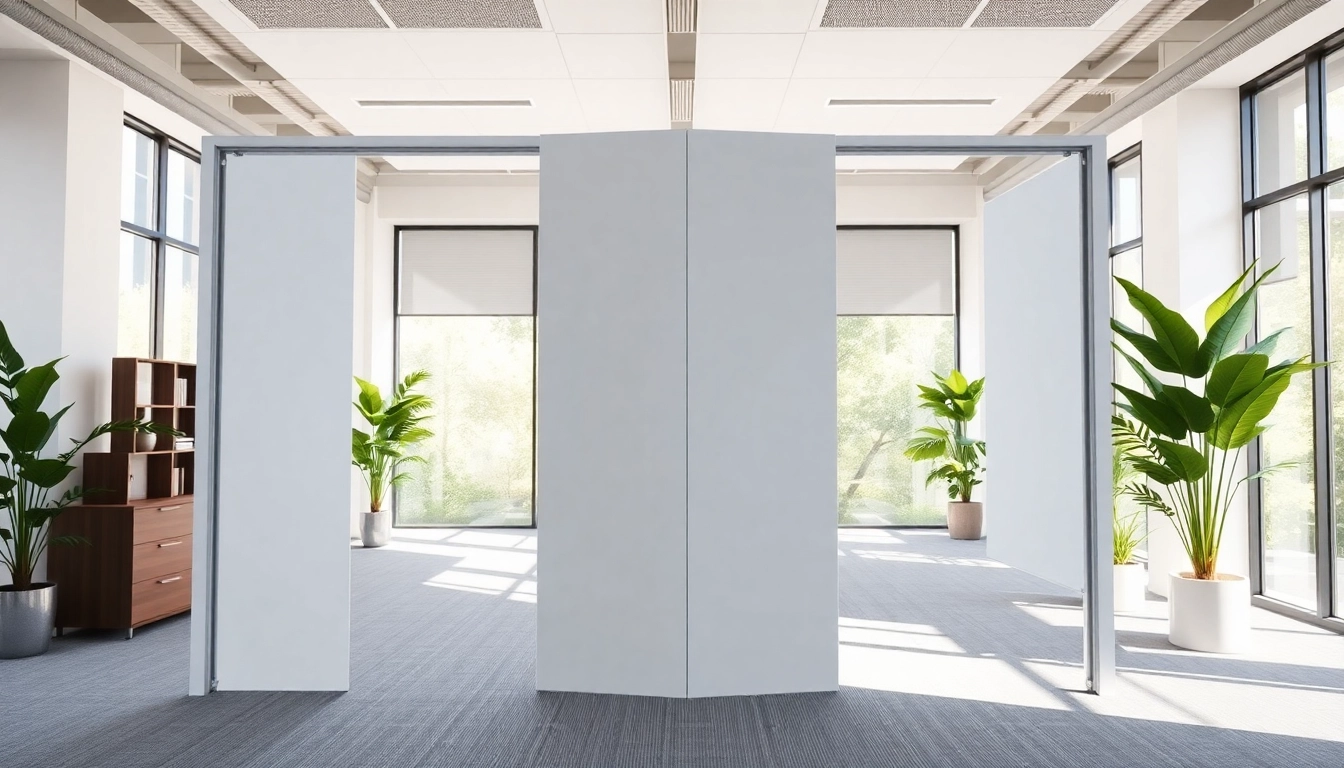Understanding Folding Partition Walls
What Are Folding Partition Walls?
Folding partition walls are versatile space management solutions designed to divide large open areas into smaller, more functional spaces. These walls operate on a system that allows them to fold away, enabling users to customize their environment according to changing needs. Unlike traditional permanent walls, folding partitions provide flexibility, efficiency, and practicality, making them an ideal choice for various applications, such as offices, schools, and event spaces. With a Folding Partition Wall, you can maximize utility without sacrificing design aesthetics.
Key Benefits of Folding Partition Walls
Folding partition walls offer a plethora of benefits that include:
- Space Optimization: Their ability to open up spaces significantly increases the functional area of a room without the need for extensive construction.
- Cost-Effectiveness: In comparison to building new walls, folding partitions often represent a more affordable solution, especially in rental environments where changes are frequent.
- Sound Control: Many modern folding partitions are designed with sound-dampening materials, which is crucial for maintaining privacy during meetings or events.
- Design Flexibility: Available in various materials, colors, and styles, they can seamlessly integrate with your existing décor.
- Ease of Installation: Folding partitions typically require less installation time and can often be transported to different locations if necessary.
Common Materials Used
The materials used to construct folding partition walls vary widely, including:
- Wood: Provides a warm, aesthetic appeal while being durable.
- Metal: Often used in commercial settings for its longevity and modern look.
- Fabric: Adds a soft finish and is commonly used in environments where warmth and comfort are required.
- Glass: Ideal for modern offices, allowing natural light to flow, while still providing the option for more privacy with frosted or tinted glass.
Design Considerations
Choosing the Right Style
Selecting the appropriate style of folding partition wall is crucial for ensuring functionality and aesthetic coherence. Some key considerations include:
- Context: Understand the primary purpose of the space. This will dictate color, texture, and even material.
- Architectural Style: Ensure that the partition’s style complements the architectural elements of the space.
- User Interaction: Depending on how people will interact with the partitions, consider features like operability and ease of use.
Acoustic Performance Factors
Acoustic performance is vital, particularly in multi-function spaces. Consider the following factors:
- Sound Ratings: Look for partitions with high sound transmission class (STC) ratings for better sound insulation.
- Material Selection: Choose materials designed for sound absorption, such as acoustic panels or specialized glass.
- Sealing Mechanisms: Ensure that edges and joints are effectively sealed to prevent sound leakage.
Color and Texture Options
Color and texture not only enhance the decor but can impact mood and functionality. Selecting complementary colors and textures can create an inviting and productive environment. Consider:
- Color Psychology: Different colors evoke varying emotions; choose tones that promote productivity or relaxation, depending on the room’s purpose.
- Texture: Mixed textures can add depth and interest to the walls, further enhancing the overall aesthetics.
Applications in Commercial Spaces
Office Environments
In office settings, folding partition walls can facilitate the creation of breakout areas, meeting rooms, and even private workstations. By integrating these partitions, businesses can:
- Encourage collaboration by easily opening up spaces for team brainstorming sessions.
- Provide privacy for confidential meetings when needed.
- Adapt their layouts quickly in response to changing project requirements.
Event Spaces and Banquet Halls
In event venues, folding partition walls are invaluable for their versatility. They can be used to:
- Create multiple smaller venues from a larger hall for various events happening simultaneously.
- Adjust the size of the banquet area according to the number of guests, enhancing client satisfaction.
- Incorporate different themes or styles easily by changing partition color or material.
Educational Institutions
Schools and universities can utilize folding partition walls in several ways. They can transform classrooms into multipurpose spaces, conduct group activities, or serve as makeshift auditoriums for presentations. Benefits include:
- Increasing engagement through collaborative learning environments.
- Optimizing space usage across various subjects and activities.
- Providing flexibility for different teaching methods and class sizes.
Installing Folding Partition Walls
Steps for Preparation and Planning
Before installing folding partition walls, a thorough preparation and plan is essential:
- Assess Needs: Determine the primary function of the wall and gather input from stakeholders.
- Measure Space: Accurate measurements of the intended area are crucial for a successful installation.
- Design Approval: Review design options and finalize colors, textures, and layout considerations.
- Budget Planning: Estimating costs, including materials and installation, helps in making informed decisions.
Hiring Professionals vs. DIY
Deciding between hiring professionals or opting for a DIY installation depends on several factors:
- Expertise: If you’re unfamiliar with wall installations, professionals will ensure proper setup and adherence to regulations.
- Time Constraints: Professional installers typically complete jobs more swiftly than the average DIYer.
- Cost: Although hiring professionals incurs additional costs, it may save money in the long run by preventing mistakes.
Maintenance and Care Tips
To prolong the lifespan of your folding partition walls, regular maintenance is critical:
- Cleansing: Use gentle cleaners and cloths to wipe down surfaces and avoid harsh chemicals that can damage materials.
- Functional Checks: Regularly inspect operating mechanisms and seals for wear or damage, ensuring functionality remains optimal.
- Servicing: Schedule periodic maintenance with professionals to address any issues before they become significant problems.
Cost Analysis and Budget Planning
Initial Investment vs. Long-Term Savings
When considering folding partition walls, it’s essential to weigh the initial investment against potential long-term savings. Factors to consider include:
- Installation Costs: Include materials, labor, and any setup fees when budgeting.
- Energy Efficiency: Well-insulated partitions can contribute to heating and cooling savings by allowing better control of airflow.
- Space Utilization: Maximizing available space can lead to additional revenue generation opportunities, especially in commercial settings.
Financial Benefits of Space Optimization
Deploying folding partition walls can lead to substantial financial benefits:
- Increased Revenue: For businesses, optimal space use can lead to more customers or events being accommodated, thus increasing income.
- Cost Reductions: Reduced need for permanent construction can lower overall facility management costs.
- Enhanced Property Value: Properties that showcase versatility are often more appealing on the market.
Funding and Financing Options
Various funding and financing options are available for those looking to install folding partition walls:
- Loans: Many banks and financial institutions offer business loans specifically designated for renovations and upgrades.
- Leasing Options: Some suppliers provide lease-to-own solutions, allowing you to spread the cost over time.
- Grants: Check for local or federal grants available for specific projects if you qualify.



